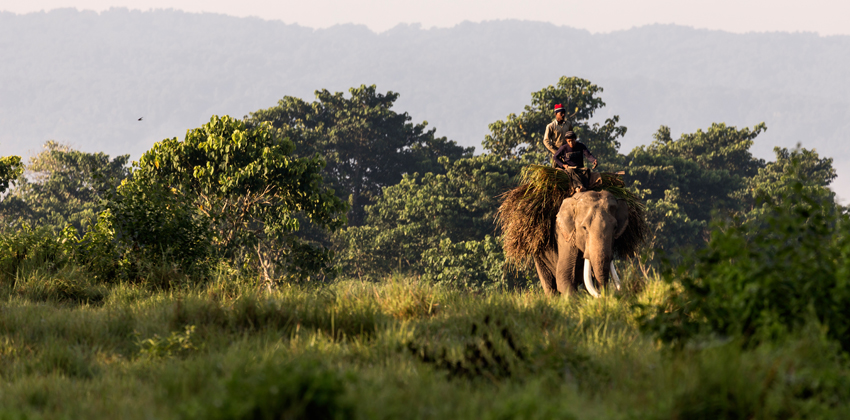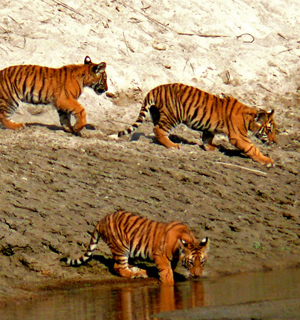
With lush green forests and exotic fauna which include the rare one horned rhino, the Royal Bengal tiger, crocodiles, elephants, deer and over four-hundred species of birds, the Chitwan National Park has on display one of the finest wildlife scenarios in Asia. Geographically located in the Terai belt, encompassed by the Churia Hills and adjacent to the Rapti, Reu and Narayani rivers, the park covers an area of 932 sq. km. It was established in 1973 and is the oldest National Park in Nepal. The park became a World Heritage Site in 1984.
During the late 19th century, Chitwan was used as a private hunting reserve of the Rana Prime Ministers. As early as 1911, King George V led a hunting party to Chitwan that culminated in the killing of thirty-seven tigers and eight rhinos. Between 1933 and 1940, the King and his guests were said to have killed four hundred and thirty-three tigers and fifty-three rhinos. For which if the late king had done that today, pet lovers would have probably surrounded his palace with protests. By the late 1960s the population of rhinos and tigers in Chitwan had decreased even further due to arbitrary hunting and poaching. The declaration of Chitwan as a national park in1973 and the obligation of strict measures against poaching and unauthorized conversion of forest to farmland have given a lifeline to the wildlife population. We now see more wildlife in the park. Currently, Chitwan National Park is regarded as one of the most developed and most commonly visited national parks in Nepal.
Things you need to bring for your safari holiday:
* Clothes of a Neutral color are much recommended.
* Light clothing is needed in the day time with a light sweater and warm jacket for the evenings from November to February.
* Pants / Trousers of the loose kind, half or full, are recommended for elephant safaris.
* Comfortable walking shoes, a sun hat, sunscreens & sunglasses etc. are essential. Insect repellents and personal medical requirements should be carried.
* It is highly advisable to travel light with only one small suitcase or a duffle bag. After all, it’s a trip into the wild.
* During the warmer months, swimming suits are recommended.
* A Small flash light is recommended.
* Binoculars can be real handy & adds to the zing in your enjoyment for bird and wildlife viewing.
Vegetation seen in the park:
The Park’s vegetation has Sal forest, open grasslands and riverside vegetation. We also see flowering species of trees like the sissoo, and silk cotton trees of the forest. These trees bloom from January to early spring and fill the forest with their colorful flowers. The tall elephant grass dominates the grass grassland and gives it that savannah like appearance.
Wildlife in the Park:
This Park is the home to the great one- horned Indian rhino, the world’s third largest land mammal. They feed largely on grass which is also their normal habitat and generally move alone or in groups. The elephants seen frequently at the park are trained and tamed. The tamed elephants are a major tourist attraction for elephant rides & also used as beasts of burden in Chitwan. The Royal Bengal tiger, the most princely and elusive of Chitwan’s animals, is estimated to number just about a hundred in Chitwan. They are by nature reclusive and do not attack unless provoked or when hunting for food. There are four different species of deer living in the park - the barking deer, the hog deer, the sambar deer and the spotted deer. Over 400 different birds have been recorded here, including the Indian peafowl, the tuneful black headed oriole and the open bill stork. The park’s rivers and the swampy areas are home to various reptiles like the pythons, crocodiles, called gharial, which feed on fishes and the marsh mugger. The common leopard, langur and rhesus monkey also make up most part of the park’s wildlife population.
Activities & getting the best out of your safaris
The elephant rides make up for the best & most exciting part of your safari holiday. An elephant ride through the jungle is an experience we should never leave out. Most lodges inside the park have their own elephants. Four people can comfortably ride atop an elephant. Elephant safaris usually start in the early morning or late afternoon .we also have the rumble-tumble jeep tours available inside the park. The best months for your safari holidays are from mid-February when the elephant grass has been cut, allowing unobstructed views. You can also take a cool hike inside the park, provided you are accompanied by at least two guides. Canoeing along the Rapti or Narayani rivers is the most relaxed way of watching the wildlife, especially the aquatic birds and crocodiles. Several lodges arrange visits to nearby Tharu villages. Tharus, the original inhabitants of Chitwan, have their own culture, language and customs which are quite different from that of the Nepalese hill people. A visit to the elephant breeding camp and the gharial breeding centre can also prove to be informative.
The most appropriate time to do your safari:
The best time to decide a visit to the park is from October to February, the parks are mellow & cozy around this time of the year. Many of the park lodges are closed between May to August due to the rainy season.
Accommodating you:
When at Chitwan, you can stay inside the park. A variety of lodges can be found, from the multi-starred ones and lodges that are basic but comfortable enough for 2-3 days. Campgrounds are not provided for campers inside the park. Budget travelers can find accommodation at Sauraha, a nearby village that has some higher end residencies as well. Most safari programs are planned with all Meals available either by the lodges, or you can enjoy ‘a la carte’ at the restaurant.
Bird Watching Programs:
When visiting Chitwan and Bardia, you will encounter rare and endangered animals such as the one-horned rhinoceros and the Royal Bengal tiger. Other species that can be found in the parks are wild elephants, sloth bears, several species of deer, leopards and langur and rhesus monkeys. Gharial and marsh mugger crocodiles and the freshwater Gangetic dolphins also can be found in the rivers. Koshi Tappu, in particular, is a bird watchers paradise, where hundreds of different species of water birds have been recorded.
-
The "2 Night / 3 Day" Itinerary Snippet:
-
Day 1: Arrival, Tharu Village Walk, and Riverside Sunset.
-
Day 2: Canoe Ride, Jungle Walk, and thrilling Jeep Safari.
-
Day 3: Bird Watching and Departure.
-
-
Professional Naturalists: Emphasize that your guides are certified naturalists who know the alarm calls of the forest, increasing the chances of predator sightings and ensuring guest safety during walking safaris.
-
Sustainable Travel: Mention that by booking with Encounters Nepal, a portion of the fee goes toward community-based conservation and the protection of the buffer zone.
-
Bird Watcher's Paradise: Explicitly mention that Chitwan is home to over 540 species of birds, making it a top destination for ornithologists.
